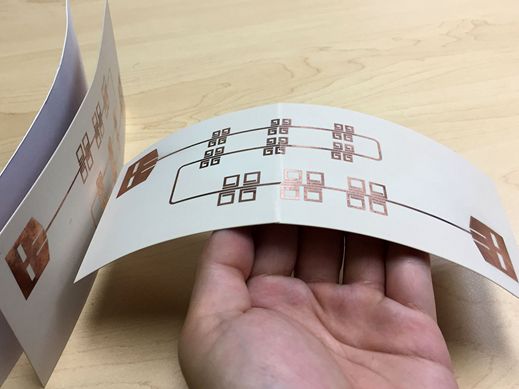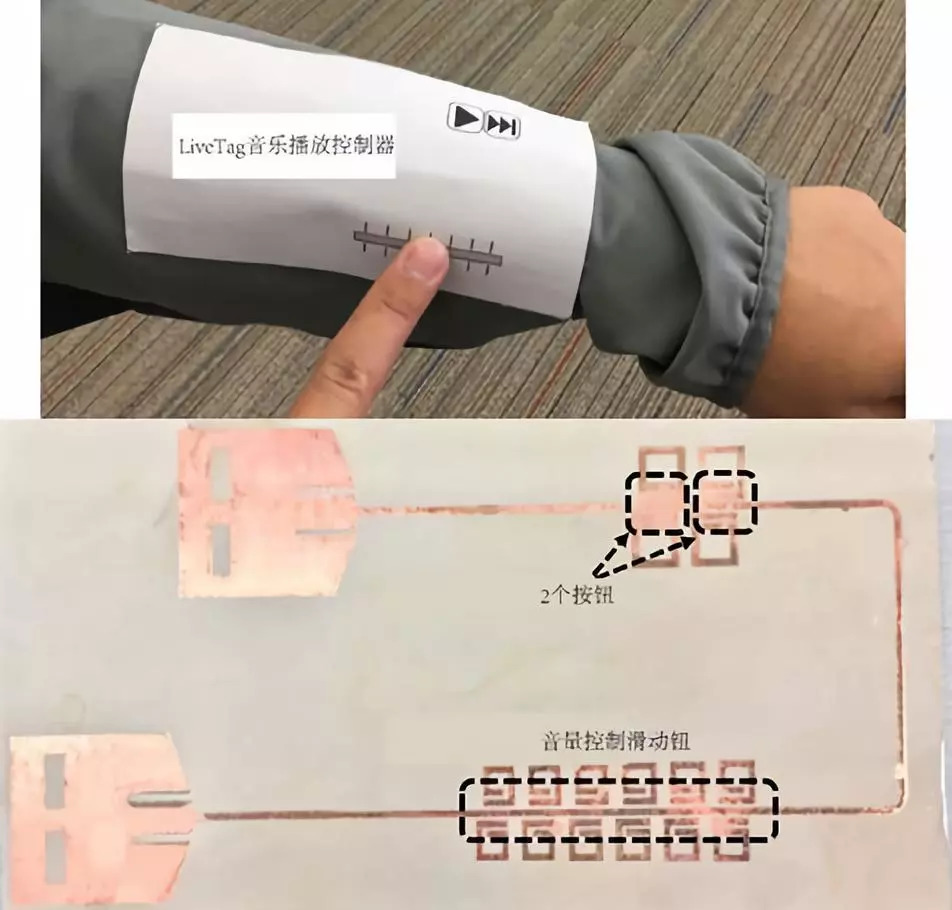Although today's electronic devices have widely adopted touch screens, most household and commercial items still do not have touch functions. Now, a new type of smart tag that uses reflected Wi-Fi signals can make these non-touch objects have touch functions. Smart tags are not a new idea, but if most previous smart tags do not rely on batteries or complex built-in chips, their functions will be severely limited and can only be used for storage and passively providing data when accessed. The recently launched LiveTag smart tag allows interactive control after being attached to objects, walls, and anything else. People can use it to remotely control a music player or learn how much water is in a house's reservoir. Photo丨Researchers show the thin and flexible LiveTag and compare it with the photo paper on the far left (Source: Xinyu Zhang/UC San Diego) Xinyu Zhang, assistant professor of electronic and computer engineering at the University of California, San Diego, said that the tag can measure the daily state of many everyday objects, including people, and allow users to interact with these items through the tag. Professor Zhang and his colleagues at the University of Wisconsin-Madison conceived the LiveTag technology during a brainstorming session on how to integrate everyday objects into the Internet of Things without attaching expensive batteries and special chips. Papers related to the design and early prototype of LiveTag: https://pages.cs.wisc.edu/~chuhan/wp-content/uploads/LiveTag_NSDI.pdf The basic functions of LiveTag seem unremarkable: additional copper printed circuits on a lightweight and flexible substrate, no additional batteries or other electronic devices. However, the design of the circuit allows LiveTag to absorb Wi-Fi signals of specific frequencies, especially for signals running on 2.4GHz and 5GHz Wi-Fi technology dedicated frequencies. The absorption of the Wi-Fi signal by each characteristic circuit will cause the Wi-Fi signal to produce an identifiable characteristic in a specific frequency spectrum. This characteristic can be read by the Wi-Fi receiver. The identifiable characteristic of each tag is different, so Be identifiable. In addition, if a person touches a different point of the label, it will change the Wi-Fi spectrum characteristics of the label, which is equivalent to pressing a certain button. For example, LiveTag can be used as a music player controller with a start-pause button and a volume control slider, as long as the nearby Wi-Fi supports this function. However, designing a circuit is not an easy task. Professor Zhang and his colleagues tried a large number of combinations of shapes, sizes and materials, and then verified the effects through computer simulations. Figure 丨 Music player controller made based on LiveTag, controlled by spectrum modulation of reflected Wi-Fi signal (Source: Xinyu Zhang/UC SanDiego) In addition, researchers must also develop customized multi-antenna beamforming algorithms for Wi-Fi devices to identify the spectral characteristics of the LiveTag, and distinguish the reflected signal from the LiveTag from the reflected signal from walls, objects, or even the human body. In order to filter out other reflected signals, the Wi-Fi control software uses multiple antennas to generate beams pointing in multiple directions. In this way, most objects that produce reflected signals in different directions can be filtered as noise, while the signal from the LiveTag is still retained. Professor Zhang and his colleagues built a LiveTag-based music controller with a switch button and a volume control sliding button, which can remotely control the music player through a Wi-Fi receiver. They also attached another LiveTag to the plastic bottle, and then showed that the LiveTag detects the position of the liquid level when it is touched. The technology can be used with smartphone apps to remind runners to regularly hydrate and avoid dehydration. Most of the previous smart tags are based on RFID chips, which can provide identification and location information of items. Scientists have also successfully implanted RFID chips in clothes and mattresses to realize health monitoring functions. However, RFID tags have extremely limited support for touch functions, and can only send out two signals of "pressed" and "not pressed". In addition, RFID performance requires special equipment to read the signal, which also limits its scope of application. A Norwegian company Thinfilm has developed smart tags based on near-field communications (NFC) chips that can be read with smartphones, but Thinfilm tags are limited to storing and responding to product information, and it seems that they do not support touch functions. Professor Zhang and his colleagues once considered using computer vision and deep learning technology to recognize whether humans are touching tags through a camera, but this idea was soon abandoned because it must rely on camera support, which is a threat to user privacy. Of course, LiveTag also has serious limitations. First of all, the tag can only work within 1 meter of the Wi-Fi device, which severely limits the application of the tag. Of course, Zhang believes that through more Wi-Fi antennas and a more complex design of the tag circuit, the usable distance can be increased. Another challenge is that 2.4GHz Wi-Fi signal bandwidth is limited, so the number of spectrum features that can be supported is limited. Specifically, the current LiveTag can only support 5-9 spectrum features. For this problem, researchers are trying to design smart tag circuits that can modulate the phase of Wi-Fi signals, which can significantly increase the number of available signal features. Despite the above limitations, the prototype of LiveTag has aroused the interest of the industry. In addition, other research teams have also proposed a variety of potential applications of LiveTag. For example, the medical field hopes to use smart tags attached to doors and daily necessities to monitor the daily health status of elderly patients. Professor Zhang said that this solution has great potential because it is non-intrusive, does not require batteries, and does not invade privacy. Shenzhen Linx Technology Co., Ltd. , https://www.linxheadphone.com
